- Understand Core Methods: Learn the ins and outs of As-Planned vs. As-Built, Impacted As-Planned, Time Impact Analysis, and Windows Analysis to dissect project delays.
- Master Documentation: Discover why meticulous record-keeping is your best ally in supporting or defending against delay claims, and how to do it effectively.
- Embrace Proactive Prevention: Shift from reactive problem-solving to proactively identifying and mitigating potential delays using forensic insights and tools like Archdesk.
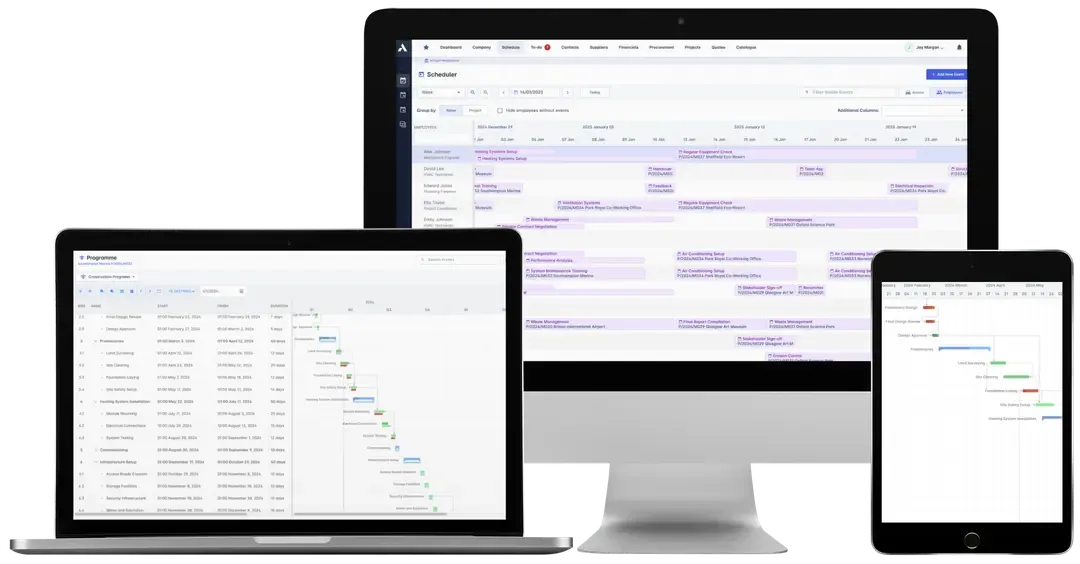
Visualizing schedule deviations is a cornerstone of forensic analysis.
What's the Big Deal About Forensic Schedule Analysis?
Beyond Just Pointing Fingers: Understanding Project Delays
Forensic schedule analysis isn't just some fancy term for looking back at what went wrong. Think of it as project archaeology – carefully digging through the layers of a project's timeline to understand precisely when, why, and how delays occurred. It’s about getting to the truth of schedule deviations. Whether you're a contractor in the US facing a potential claim on a high-rise build or a project manager in the UK trying to understand why a transportation project overran, this analysis is your toolkit.
The primary goal is to identify the cause-and-effect relationships between specific events and their impact on the project's critical path and completion date. This often becomes crucial in disputes, helping to determine liability for delays and associated costs. For example, was the delay caused by the owner's changes, unforeseen site conditions, contractor inefficiencies, or a supplier failing to deliver on time?
The Cost of Getting It Wrong (and the Rewards of Getting It Right!)
Project delays are more than just frustrating; they can be incredibly costly. We're talking liquidated damages, extended overheads, lost productivity, and even damaged reputations. In the construction world, delays can quickly escalate, turning profitable projects into financial drains. A robust forensic schedule analysis can be the key to fairly resolving claims, recovering entitled compensation, or defending against unjustified penalties. For instance, a UK-based firm might use it to claim an Extension of Time (EOT) due to client-driven scope changes, while a US counterpart might use it to refute claims of contractor-caused delays by demonstrating concurrent delays from the owner.
But it's not all about disputes. The real power move is using these analytical insights proactively. By understanding past pitfalls, you can better anticipate risks, refine your scheduling practices, and implement mitigation strategies on current and future projects. Imagine identifying a recurring bottleneck in your material procurement process through analysis and fixing it before it impacts your next big project. That’s the proactive power of forensic scheduling.
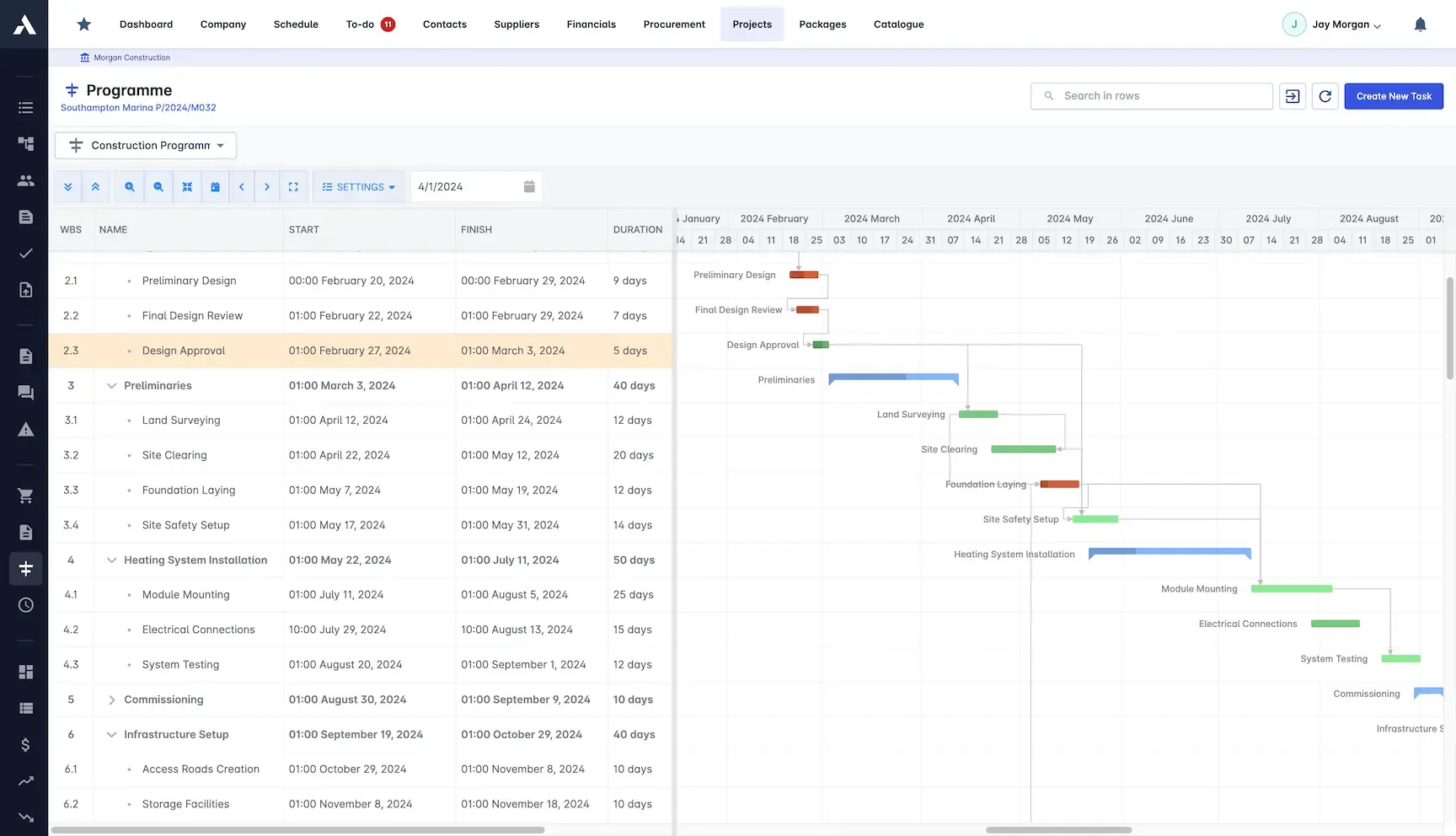
Detailed graphical reports are essential outputs of forensic schedule analysis.
The Detective's Toolkit: Unpacking Forensic Schedule Analysis Methods
There's no one-size-fits-all method for forensic schedule analysis. The technique you choose often depends on the complexity of the project, the data available, the stage of the dispute, and contract requirements. Let's explore the most common approaches:
1. As-Planned vs. As-Built (APvAB) Analysis
The Fundamental Comparison
Concept: This is often the starting point. It involves a straightforward comparison of the original baseline (as-planned) schedule with the actual (as-built) schedule, highlighting variances in start dates, finish dates, and durations of activities.
How it Works: You overlay the two schedules and identify where things deviated. For example, if "Foundation Work" was planned for 20 days but took 30, this method flags that 10-day difference.
Pros: Simple to understand and visually demonstrate. Relatively quick to perform if good records exist.
Cons: It's observational and doesn't inherently show causation or account for changes to the critical path during the project. It may not be robust enough for complex disputes with multiple schedule updates.
US/UK Example: A UK residential builder planned a house extension to finish by October 1st. The as-built showed completion on November 15th. APvAB clearly identifies the 6-week delay. Similarly, a US commercial contractor might find a concrete pour happened two weeks later than planned using this method.
Archdesk's Role: Archdesk's version control for schedules is invaluable here. It stores every iteration of your plan, allowing you to easily pull up the original baseline and compare it against the final as-built data, which is also meticulously tracked within the system through progress updates.
2. Impacted As-Planned (IAP) Analysis
The "What If" Scenario
Concept: This method takes the original as-planned schedule and "impacts" it by adding specific delay events (e.g., owner-requested changes, severe weather events) to see their theoretical effect on the project completion date.
How it Works: You model the delays as new activities or extended durations within the baseline schedule and then recalculate the schedule. The difference between the original planned completion and the new impacted completion date represents the alleged delay caused by those events.
Pros: Relatively simple to execute and can be useful for illustrating the potential impact of isolated, distinct delay events.
Cons: It's a hypothetical model that doesn't consider actual progress or other concurrent delays. It can be criticized for not reflecting the dynamic nature of a real project.
US/UK Example: A US bridge construction project anticipates a 4-week delay for a specialized steel component. Using IAP, the contractor inserts this potential delay into their original schedule to forecast the impact on the bridge's opening date. A UK fit-out contractor could use IAP to show a client how a potential delay in custom furniture delivery would affect overall completion.
Archdesk's Role: Archdesk allows you to duplicate schedules and create these "what-if" scenarios. By linking documented delay events (like RFIs or change orders logged in Archdesk) to these impacts, you add credibility to your IAP model.
3. Time Impact Analysis (TIA)
The Dynamic Assessment
Concept: TIA is a more dynamic and often preferred method, especially when conducted contemporaneously (as events occur). It involves inserting a "fragnet" (a small network of activities representing the delay event and its logic) into the most current, updated project schedule at the time the delay event occurred or was known.
How it Works: When a delay event arises (e.g., a design change, a crane malfunction), you update the project schedule to reflect progress up to that point. Then, you insert the fragnet representing the delay and recalculate the schedule to determine the impact on the critical path and project completion.
Pros: More accurate as it considers the project's actual status at the time of the delay. Often required by contracts for substantiating EOT claims.
Cons: Can be complex and time-consuming, requiring disciplined schedule updates and accurate fragnets. The quality of the underlying schedule is critical.
US/UK Example: On a large UK infrastructure project, unexpected ground conditions cause excavation delays. A TIA is performed by adding this delay into the current schedule to show the client the likely overall project delay. A US high-rise project experiencing a crane malfunction uses TIA to demonstrate its effect on the critical path and completion date.
Archdesk's Role: Archdesk’s meticulous version control of schedules and its ability to log detailed progress updates are essential for TIA. You can pinpoint the correct schedule version and have the supporting documentation (photos of ground conditions, maintenance reports for the crane) readily available within the system to build an accurate fragnet and impact assessment.
4. Windows Analysis (or Period Analysis)
The Segmented Deep Dive
Concept: This method breaks down the total project duration into smaller, sequential time periods or "windows" (e.g., monthly or quarterly). The schedule is analyzed within each window to identify critical path changes and delays occurring during that specific period.
How it Works: For each window, you establish the critical path at the start and end. Delays are quantified and apportioned within that window. The cumulative impact is then assessed across all windows.
Pros: Excellent for complex projects with multiple overlapping delays and frequent schedule updates. Helps in identifying concurrent delays and apportioning responsibility more accurately over time.
Cons: Highly data-intensive and can be very time-consuming and costly to perform. The choice of window periods can sometimes influence the outcome.
US/UK Example: A large industrial plant construction in Texas (US) with numerous contractors uses Windows Analysis to examine monthly progress and untangle concurrent delays. A major UK railway upgrade project uses it to analyze delays within specific phases or between handovers.
Archdesk's Role: Archdesk’s comprehensive project data, including dated daily logs, progress reports, and schedule updates, provides the rich dataset needed for Windows Analysis. Its reporting features can help segment data by date ranges, facilitating the window-by-window examination.
Comparative Overview of FSA Methods
Choosing the right forensic schedule analysis method is crucial. The table below offers a snapshot comparing the key techniques, highlighting their main concepts, ideal use cases, and general pros and cons to help you understand which might be most appropriate for your situation.
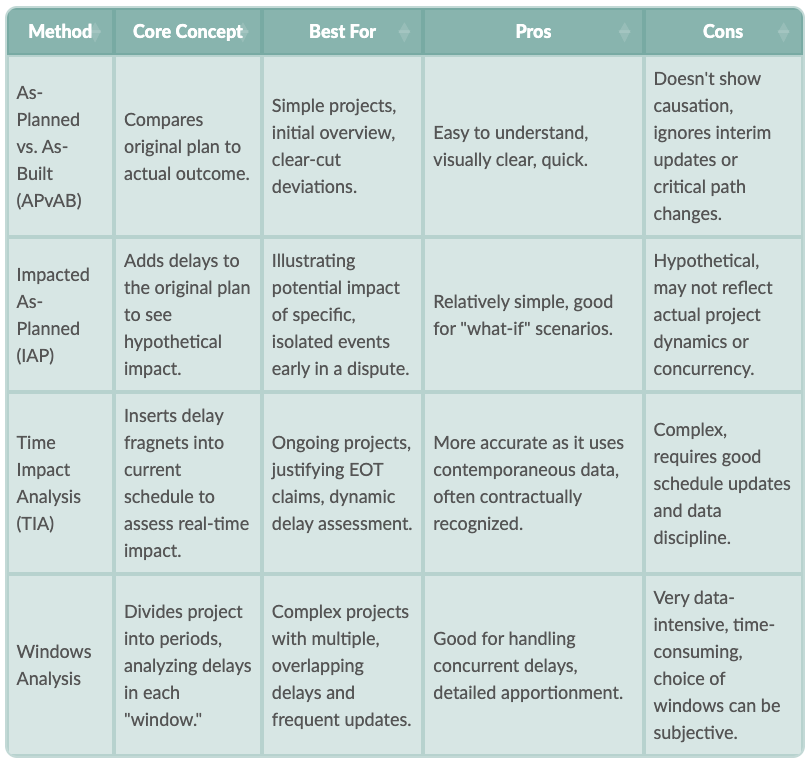
Visualizing Method Characteristics: A Radar View
To further understand how these methods differ, the radar chart below provides a visual comparison across several key characteristics. Each axis represents a factor, and the colored lines show how each FSA method scores on these aspects. This can help in selecting a method based on project needs, available data, and desired outcome. For instance, TIA scores high on "Accuracy for Claims" and "Proactive Utility" but also on "Complexity" and "Data Intensiveness." Note that these are generalized assessments.
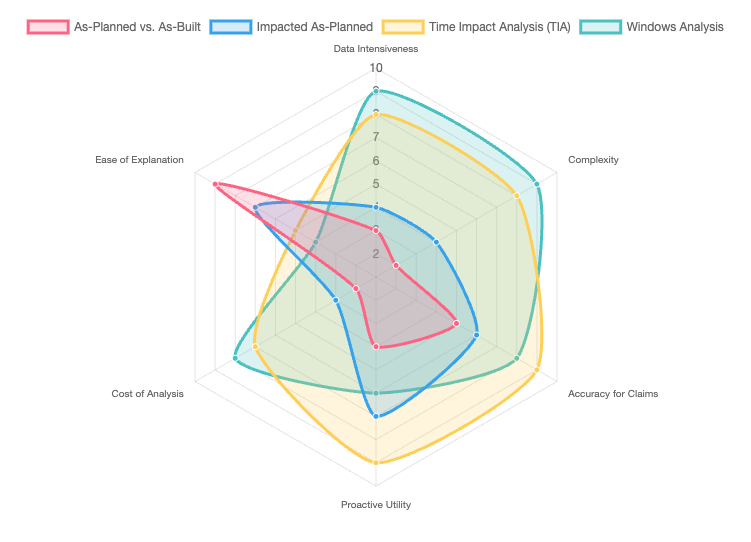
Your Secret Weapon: The Power of Pristine Project Records
Regardless of the analysis method chosen, its success hinges on one critical factor: the quality and completeness of project documentation. You can't analyze what you haven't recorded! Think of your documentation as the evidence file for your project's story.
What to Document? The Essential Checklist
Comprehensive records are non-negotiable. Here’s a rundown of what you should be meticulously capturing:
- Schedules: All versions – baseline, regular updates, revisions, and as-built schedules. Critical path reports are also key.
- Daily Reports/Logs: Details of work performed, weather conditions, resources on site (labor, equipment), any issues encountered, safety incidents, and visitors.
- Meeting Minutes: Records of all project meetings, decisions made, and action items assigned.
- Correspondence: All project-related communications – emails, letters, formal notices, RFIs and responses, transmittals.
- Change Orders & Variations: Approved and rejected change orders, including scope, time, and cost implications.
- Photographs and Videos: Dated visual evidence of site conditions, progress, problem areas, and completed work.
- Financial Records: Cost reports, invoices, payment applications, and records of delay-related costs.
- Material & Equipment Logs: Delivery tickets, inspection reports, and records of equipment usage and downtime.
How Archdesk Elevates Your Record-Keeping
This is where a robust construction management platform like Archdesk becomes a game-changer. Instead of scattered spreadsheets, emails, and paper files, Archdesk provides a centralized, organized repository for all project information.
- Centralized Data Hub: All documentation, from schedules to daily logs to financial data, is stored in one accessible place, linked to the specific project.
- Version Control: Archdesk automatically tracks versions of schedules and other key documents. This ensures you can always access historical states, crucial for methods like TIA or As-Planned vs. As-Built.
- Communication Logs: Important communications can be logged and linked to project activities or issues, providing context and a clear audit trail. No more hunting through endless email chains!
- Timestamping & Audit Trails: Archdesk automatically timestamps entries and creates audit trails, adding a layer of integrity to your records. This is vital for establishing the contemporaneous nature of information.
Imagine needing to prove when a critical design instruction was received for a TIA. With Archdesk, that RFI and its response, along with the date stamps, are easily retrievable and linked to the relevant schedule activities. This dramatically simplifies the data gathering phase of any forensic analysis.
Mapping the World of Forensic Schedule Analysis
To get a bird's-eye view of how these concepts interrelate, the mindmap below illustrates the key components of Forensic Schedule Analysis. It branches out from the central theme to cover the driving reasons for conducting FSA, the principal methods employed, the critical role of documentation, strategies for proactive mitigation, how technology like Archdesk facilitates the process, and common challenges encountered.
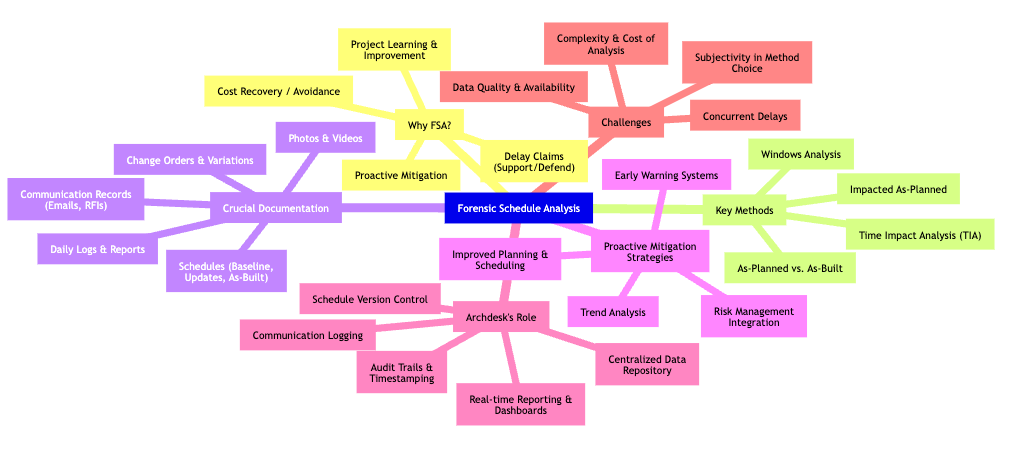
More Than Just Hindsight: Using FSA for Proactive Wins
While forensic schedule analysis is often associated with dissecting past events for claims, its true strategic value lies in using those insights to improve current and future project performance. It’s about shifting from a reactive stance to a proactive one.
Turning Insights into Action
Analyzing past delays can reveal patterns and root causes. Were delays frequently caused by late material deliveries? Were design clarifications a common bottleneck? Understanding these trends allows you to:
- Refine Scheduling Practices: Make your initial schedules more realistic by incorporating lessons learned about task durations and dependencies.
- Improve Risk Management: Identify recurring risks and develop specific mitigation plans. If weather constantly delays groundwork on UK sites in winter, build in more float or plan alternative indoor work.
- Enhance Stakeholder Communication: If unclear communication led to past delays, implement better protocols or use collaborative platforms more effectively.
- Optimize Resource Allocation: Past performance data can help you better forecast resource needs and identify potential chokepoints.
Archdesk: Your Partner in Proactive Prevention
A system like Archdesk is not just a record-keeper; it's a proactive management tool. Here's how it helps prevent delays before they escalate:
- Real-time Dashboards & Reporting: Archdesk can provide dashboards that visualize project progress against the plan. KPIs like Schedule Performance Index (SPI) can flag deviations early. If a critical path task in a US commercial build starts slipping, it's immediately visible.
- Automated Alerts: Set up alerts for when tasks are nearing deadlines or falling behind. This prompts timely intervention.
- Improved Collaboration: Centralized communication and document sharing ensure everyone is working from the same information, reducing misunderstandings that can lead to delays.
- Data-Driven Forecasting: By analyzing historical data stored in Archdesk from similar projects, you can make more accurate forecasts for new projects, identifying potential problem areas upfront.
For instance, if Archdesk's reports consistently show a particular subcontractor in the UK underperforming on schedule, you can address this proactively in future bids or resource planning, rather than waiting for another delay to analyze retrospectively.
Choosing Your Tech Ally: How Archdesk Stacks Up
When it comes to managing the complex data required for forensic schedule analysis and proactive delay mitigation, not all construction management software is created equal. While tools like Procore, Autodesk Construction Cloud, Aconex, Fieldwire, Viewpoint, or Buildertrend offer various scheduling and project management features, Archdesk brings particular strengths to the table, especially for companies keen on robust data integrity for analysis.
The key differentiator for Archdesk often lies in its integrated approach. Rather than having scheduling data in one silo, financial data in another, and communications in yet another, Archdesk aims to bring these together. For forensic analysis, this is gold. Being able to easily cross-reference a schedule delay with logged communications, attached photographic evidence, and related change order documentation, all within a single system with clear versioning, significantly streamlines the often-painful data gathering and correlation process. This integrated data model is what underpins reliable forensic analysis and powerful proactive reporting.
Furthermore, Archdesk's focus on maintaining auditable version control for schedules and key documents ensures that the historical record needed for methods like TIA or Windows Analysis is preserved and accessible. While competitors also offer document management, the ease with which Archdesk connects disparate pieces of information relevant to a schedule deviation can save considerable time and effort, making detailed analysis more feasible, even for small to medium-sized enterprises.
From Theory to Trenches: FSA Case Snippets
Let's look at some brief, illustrative examples of how these techniques might play out:
- US High-Rise (New York): A contractor faced claims for a 3-month delay. Using Windows Analysis, supported by meticulously logged daily reports and progress photos in their project management system (akin to Archdesk), they demonstrated that 6 weeks of the delay were due to owner-issued changes impacting the critical path in specific "windows," while another 2 weeks were concurrent delays due to unforeseen utility conflicts. This allowed for a more equitable resolution.
- UK Infrastructure Project (Birmingham): A planned rail upgrade was delayed. The contractor used Time Impact Analysis contemporaneously each time a significant new instruction was received from the client. By submitting these TIAs regularly, showing the impact of each change on the completion date, they secured necessary Extensions of Time progressively, avoiding a major dispute at project end. Archdesk's version control would have been crucial for storing each schedule iteration used for the TIAs.
- US Commercial Build (Texas): A general contractor proactively used insights from an As-Planned vs. As-Built analysis of a past project which revealed significant delays due to a specific roofing subcontractor. For a new, similar project, they allocated more float to roofing activities and enhanced monitoring for that trade, successfully avoiding a repeat delay.
- UK Residential Development (Manchester): A developer used Impacted As-Planned analysis during the planning phase to model the potential impact of local authority planning approval delays, a common issue in the area. This helped them set more realistic investor expectations and build contingency into their master program.
Frequently Asked Questions (FAQ)
What's the primary goal of Forensic Schedule Analysis?
The primary goal is to retrospectively determine the causes of project delays, quantify their impact on the schedule (particularly the critical path and completion date), and assign responsibility for those delays. This information is often used in resolving claims, but also for learning and improving future project planning and execution.
How often should Forensic Schedule Analysis be performed?
While "forensic" implies a post-project investigation, elements of it, like Time Impact Analysis, are best performed contemporaneously (as events occur) to support EOT claims or proactive adjustments. A full forensic analysis is typically done when a dispute arises or at project completion for lessons learned. Regular schedule reviews incorporating analytical thinking are always beneficial.
Can Forensic Schedule Analysis prevent all delays?
No, it cannot prevent all delays, as unforeseen events are inherent in construction. However, by understanding past delay causes and using analytical techniques proactively (e.g., through regular schedule monitoring and "what-if" scenarios), it can help identify potential delays earlier, allowing for mitigation strategies that can reduce their frequency or impact.
Is Forensic Schedule Analysis only for large, complex projects?
While more sophisticated methods like Windows Analysis are common on large projects, the principles of forensic schedule analysis and the importance of good record-keeping apply to projects of all sizes. Simpler methods like As-Planned vs. As-Built can be valuable even for smaller jobs, especially if disputes arise or for improving future estimating.
What is "concurrent delay" and how does FSA handle it?
Concurrent delay occurs when two or more independent delay events (one attributable to the owner, one to the contractor, for example) affect the critical path during the same period. FSA methods like Windows Analysis are particularly suited to identifying and attempting to apportion concurrent delays. The treatment of concurrent delays often depends on contract terms and legal jurisdiction; generally, if true concurrency exists, the contractor may get time but not costs.
References
- Schedule Analysis Methods - AACE 29R-03 Recommended - Long International
- Guide to the Forensic Scheduling Body of Knowledge - PMA Consultants
- Forensic Schedule Delay Analysis Methodology - Project Control Academy
- Methods of Forensic Schedule Delay Analysis: Pros and Cons - Smith Currie
- Construction Delay Claims - Helix Law
- Construction delay claims - Harper James
- Analysis of Concurrent Delay on Construction Claims - Long International
- Archdesk Construction Management Software - Archdesk
- Delay Analysis Methodologies - Spire Consulting Group





